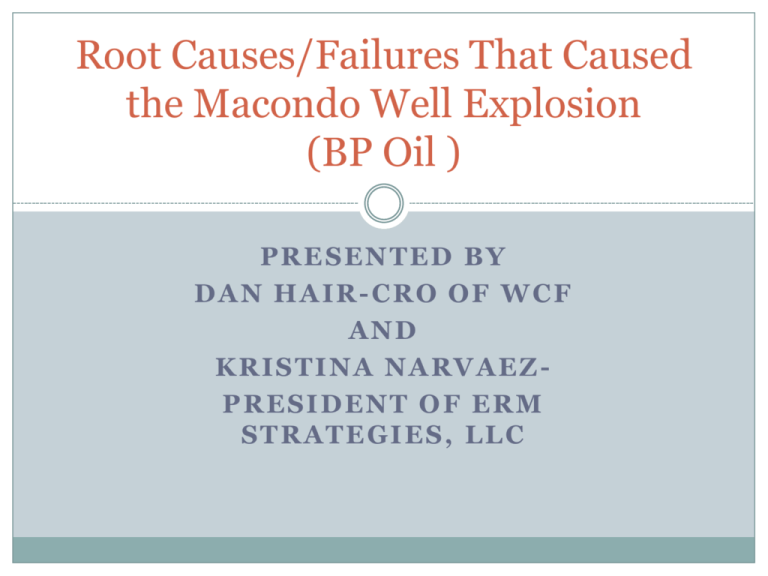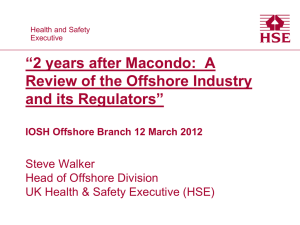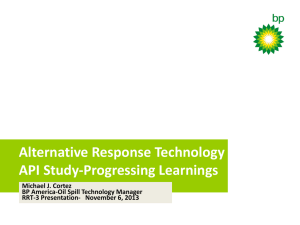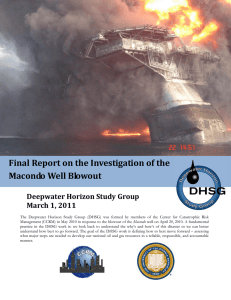Root Causes/Failures That Caused the Macondo
advertisement

Root Causes/Failures That Caused the Macondo Well Explosion (BP Oil ) PRESENTED BY DAN HAIR-CRO OF WCF AND KRISTINA NARVAEZPRESIDENT OF ERM STRATEGIES, LLC History of Macondo Well In March 2008, BP paid a little over $34 million to Minerals Management Service for an exclusive lease to drill in Mississippi Canyon Block 252, a nine square mile plot in the Gulf of Mexico Although the Mississippi Canyon area has many productive oil fields, BP knew relatively little about the geology of Block 252 Two years later, BP was paying out tens of billions of dollars Report to President National Commission on BP Oil Spill The Chief Counsel‟s Report focuses primarily on the blowout and it‟s technical causes while the Commission looked at containment and response issues The Chief Counsel‟s Report focuses primarily on the blowout and it‟s technical causes while the Commission looked at containment and response issues Root Causes/ Failures of Macondo Well Explosion Most significant failure at Macondo and clearly the root cause of the blowout was a failure of industry management. ( p. 123 ) BP‟s management process did not adequately identify or address risks created by late changes to well design and procedures. ( p.123 ) Decision making process at Macondo did not adequately ensure that personnel fully considered the risks created by time and money saving decisions. ( p.125 ) Root Causes/Failures of Macondo Well Explosion The well blew out because a number of separate risk factors, oversights and outright mistakes combined to overwhelm the safeguards meant to prevent just such an event from happening ( p.90 ) Better management by BP, Haliburton and Transocean would almost certainly have prevented the blowout by improving the ability of individuals involved to identify the risk they faced, and to properly evaluate, communicate and address them. ( p.90) Additional Resources British Petroleum Deepwater Accident Investigation Report 192 pages – September 2010 Drowning in Oil: BP and the Reckless Pursuit of Profit Loren C. Steffy – McGraw-Hill 2011 In Too Deep – BP And The Drilling Race That Took It Down Reed & Fitzgerald 2011 Bloomberg Press Lessons Learned From the Past “Those who don't know history are destined to repeat it.” Edmund Burke "Those who cannot remember the past are condemned to repeat it.“ George Santayana “What has been will be again, what has been done will be done again; there is nothing new under the sun. “ Ecclesiastes 1:9 Learning From Disaster Exxon-Valdez disaster punitive damages $5 Billion? Reputational Damage? “That accident was the low point in ExxonMobile‟s history. But it was also a turning point.” Rex Tillerson – Chairman of ExxonMobile Exxon Develops New Strategy 11 step system of safety processes used throughout the company A risk matrix used which triggers referral to higher levels of management Even cost-cutting proposals would go through a risk assessment process first Walking the Walk - Blackbeard In 2007 Exxon abandoned an ultra-deep well known as Blackbeard, 32,000 feet below the sea floor in the gulf in shallow water and walked away from a $200M investment Exxon‟s Drillers were concerned about drilling complications, extreme pressures and temperatures, and conditions (very similar to BP‟s Macondo well) suggesting a blowout was possible The decision to stop drilling went all the way to the top – Tillerson supported the drillers‟ concerns Business Week was critical, running a piece asking whether the company was “a Juggernaut or a dinosaur?” BP – Similar History – Different Results Culture Under Chairman John Browne: Endless cost cutting and management changes Focusing on the “cheap part” of safety at the expense of investing in and maintaining facilities, mechanical integrity and process safety Lack of accountability Loss of experienced personnel and a culture of intimidation Results -I In March 2004 an ultraformer unit explosion at the Texas City Refinery resulted in 14 OSHA violations and a $63,000 fine 2 months later a worker fell to his death in a tank A few months later a worker burned to death in an accident BP hired an outside consultant to look at the plant “We have never seen a site where the notion „I could die today‟ was so real for so many hourly people” March 2005 multiple maintenance failures cause explosion in ISOM unit- 15 deaths + 200 injuries Results -II March 2006 – BP Prudhoe Bay pipeline ruptures leaking 4800 barrels a day BP had neglected maintenance to save money so badly that they were afraid to run “pigs” through the lines for fear that they would rupture BP records discovered later showed that heavy cost cutting led the company to forego standard maintenance Results - III April 2010 Macondo well blowout and explosion takes the lives of 11 workers and spills 4.9 million barrels of oil into the gulf Macondo – Immediate Causes Failure of the primary cementing possibly due to using “long string” well casing even after initial modeling suggested reliability problems Misreading and failure of well “negative pressure tests” due to lack of standard procedures, risk assessment procedures , inadequate training for rig team and poor communication Poor temporary abandonment procedures replacing mud with seawater Failure and misreading of kick detection data by onboard crew Catastrophic failure of Blow Out Preventer Root Causes Industry management failures – ultra deep Poor risk assessment of late design changes and decision making processes within BP; no MOC processes Poor communication between BP and other contractors (Halliburton, etc.) Failure to communicate lessons from earlier near-miss by drilling contractor (Transocean) Inadequate consideration of risks created by time and money saving decisions Examples of Decisions That Increased Risk “The Commission cannot say whether any person at BP or another company at Macondo consciously chose a riskier alternative because it would cost the company less money” Culture Counts Oilfield rig culture of accepting risks as part of the job – fatalism BP pressures to “bring in an elephant” – corporate strategy hinged on bringing online new large fields BP culture change from engineering excellence to cost cutting and reliance on outside consultants The Reason Theory of Accident Causation – Even when dedicated professionals do their best the flaws sometimes line up Root Cause AnalysisPart of An Overall Risk Assessment Root cause analysis is often seen as a separate function to the risk management program. Instead it should be a key tool in the risk assessment process. Root cause analysis should be used to assess both the upside and downside outcomes of risks and made available to the decision makers within an organization. Decision makers will make better decisions with accurate information on the risks they face. Benefits of Root Cause Analysis Root cause analysis is a structured process designed to help an organization to define problems that caused past events, understand the causes, and most importantly prevent future incidents. A root cause analysis program has the most positive impact on reducing or eliminating risk when it is directly integrated within an Enterprise Risk Management program. Three Basic Causes Involved in RCA Physical causes – A tangible or material item failed in some way. For example, a car's brakes stopped working. Human causes - People did something wrong or did not doing something that was required. Human causes typically lead to physical causes. For example, no one filled the brake fluid or the brake pads where not changed which led to the brakes failing. Organizational causes - A system, process, or policy that people use to make decisions in doing their work is faulty. For example, no one person was responsible for vehicle maintenance and everyone assumed someone else had filled the brake fluid or changed the brake pads Nine Step Approach to Root Cause Analysis 1) Verify the incident and define the problem 2) Map a timeline of events 3) Identify critical events 4) Analyze the critical event‟s cause and impact 5) Identify root causes 6) Support each root cause with evidence 7) Identify and select the best solutions 8) Develop recommendations 9) Track implementation of solutions Different Types of Root Cause Analysis 5 Whys Analysis- Ask a series of questions on why events happened used by Toyota Barrier Analysis –Tracking potential obstacles Change Analysis-Change in procedures or processes Casual Factor Tree Analysis-Use a logic tree structure to track given consequence Fish–Bone Diagrams-Cause and effect diagram that looks like a fish Parent Analysis-80% of problems are caused by a few critical causes Fault Tree Analysis-Consequences lead to causes Failure Mode Effect Analysis-Causes lead to consequences Fault Tree Analysis Compared to Failure Mode Effects Analysis Fault Tree Analysis Takes a particular system failure and trace the events leading to the system failure backwards in time Consequences lead to causes Failure Mode Effects Analysis An analysis that reverses the direction of reasoning in fault tree analysis by starting with causes and branching out to consequences Causes lead to consequences Fault Tree Analysis Used in Investigation of Macondo Well Explosion RIMS Risk Maturity Model Seven Attributes of Risk Maturity Model Adoption of ERM-based approach ERM process management Risk appetite management Root cause discipline Uncovering risks Performance management Business resiliency and sustainability Root cause discipline-This attribute focuses on the emphasis placed on searching for root causes of risks, including classifying risks, uncovering risk sources, and focusing on improving internal control responses to risks. Root Cause Analysis in Strategic Planning • Identify barriers and the causes of problems, so that permanent solutions can be found. • Develop a logical approach to problem solving, using data that already exists in most operations. • Identify current and future needs for organizational improvement. • Establish repeatable, step-by-step processes, in which one process can confirm the results of another.








